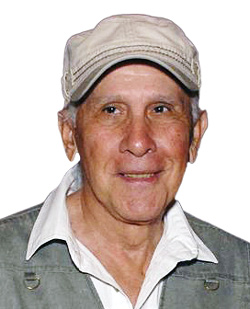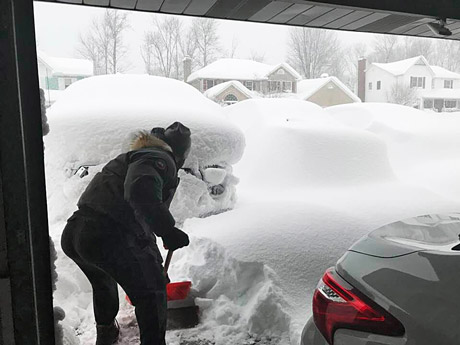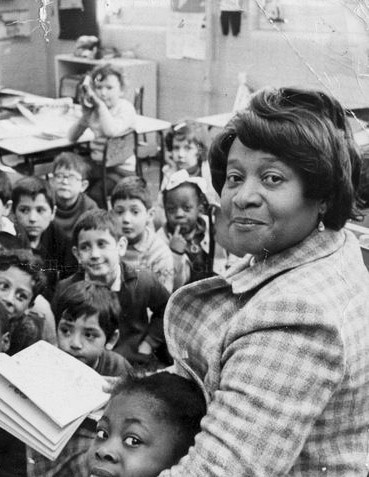March 21, 2017 issue
Authors' & Writers' Corner
blizzard papa!

Bernard Heydorn
The Boxing Day blizzard that my wife and I drove through on the evening of December 26, was a blizzard of blizzards - a blizzard papa! It caught us in Erie, Pennsylvania, without warning. Returning from spending Christmas with our daughter and family in the Richmond area of Virginia, it was a rude welcome to winter. I had checked the forecast for the route ahead of time and it called for two days of sunshine. As we approached the outskirts of the city of Erie, Pennsylvania, we saw trees covered with snow. Ironically, Erie is directly opposite St. Williams in Ontario where we live. Only 25 miles of
As soon as we left Erie I knew we were in trouble. Darkness had descended and there was only one lane of slowly moving vehicles on an icy, snow-covered road. I tried to find a radio station to get a fix on the weather but without success. I figured we were in for a long and dangerous drive on the last leg of our journey home.

To my dismay, the exits were blocked by heaps of stacked and blowing snow. Some vehicles were parked and stuck as they tried to exit. White-outs became common and our windshield became almost impossible to see through as a result of condensation and snow. The wipers were going at full blast and the windshield wiper fluid was running constantly.
It was just about time to start panicking! There was no escaping this blizzard. Vehicles put on their flashing hazard lights. We started to get low on gas. I had never experienced this kind of driving conditions in North America after over 50 years of driving.
Suddenly a car overtook us in the other lane. “It must be an impatient lunatic”, I thought. Then I realized that the snow had started to ease up. More vehicles passed us. The road became a little more visible. We had been driving for about one and a half hours in the storm, probably about 30 to 40 miles – bare knuckle driving.
The conditions steadily improved as we crossed the state line from Pennsylvania into New York, heading for the city of Buffalo. The worst was over. The tension had been terrible. The dogs of winter had descended on us with a vengeance. When I saw the bridge in Buffalo to cross over to Canada, I realized that the Gods had spared us. After a journey of over 13 hours, we finally reached home safely.
What had we learned from the experience? Have snow tires on your vehicle in winter. Don’t drive at night, if you can avoid it. Have lots of gas and windshield wiper fluid. Tune into a weather station to get the latest weather forecast. Have a reliable vehicle, carry a snow shovel, flares, and emergency phone . Last but not least, keep a steady hand on the wheel. The rest is up to the fates. If the creeks don’t rise and the snow does not fall, I’ll be talking to you.
Caribbean writing

By Romeo Kaseram
Beryl Agatha Gilroy (neé Answick) was born on August 30, 1924, in Springlands, Corentyne, Berbice, in what was then British Guiana. She was born into a large, extended family, which was guided by maternal grandmother, herbalist Sally Louisa James, born in 1868, and died in 1967, who looked after the family’s small-holding. Gilroy’s grandmother was literate and a dedicated reader; she was also a story-teller, and immersed the young girl in the folklore, colloquial Guyanese sayings and proverbs, and the knowledge of local, medicinal plants. As a young girl, Gilroy did not enter full-time schooling until she was 12 years old. According to Peepal Tree, the grandmother “took the view that the child would learn more by being taken all over the county with her, and being given space for wonder and enquiry, than in the regimented system of primary schooling”. Consequently, Gilroy entered full time schooling at a later age. However, as Peepal Tree notes: “It is clear that much of her grandmother’s influence persisted in… Gilroy’s own philosophy of education… that stressed freedom for discovery within a framework of basic skills. She recalls the importance of the gift her grandfather gave her of a dictionary after suffering the humiliation of laughter over some childish misuse of a word. Her grandmother also taught that people should avoid ‘spirit poorness’ (victimhood) and this philosophy permeates all… Gilroy’s writing.”
Following her late start in the school system, she attended the Teacher's Training College in Georgetown from 1943 to 1945, where she acquired a first-class diploma. After this, Gilroy taught and lectured on a UNICEF nutrition program. When she was 27 years old in 1951 Gilroy was selected to attend university in the UK. Here she attended the University of London until 1953, acquiring a Diploma in Child Development. Gilroy tells us in her autobiography the decision to pursue further studies in the UK, rather than the US, was due to the exchange rate rather than visions of living in Britain.
It was difficult living in the UK then for persons from the Windrush generation. As the Encyclopedia of AfroEuropean Studies tells us: “London in the 1950s was not the most welcoming of places for a young aspiring black woman. Despite her first-class teaching certificate and a top-class diploma in child development, Gilroy found it difficult to find a position as a teacher and was forced to search for employment in domestic service, dish washing and factory work. Eventually she was employed by the Inner London Education Authority and taught until 1956, years that would provide the source material for Black Teacher, her autobiographical account of the effects of class and race on educational experiences for teachers and pupils alike.” Gilroy returned to teaching in 1968, and later became the first Black headteacher in London at Beckford School in West Hampstead. She tells of her experiences during these years in the autobiographical Black Teacher (1976).
According to The Guardian, the autobiography’s publisher “softened” the narrative of Black Teacher, noting “it was a harsher account of the conditions of her mainly white, working-class pupils, and of the obstacles facing black teachers, than that of ER Braithwaite’s To Sir With Love (1959). Braithwaite was one of the first post-war West Indian writers resident in London whom Beryl got to know”. The Guardian goes on to note Gilroy “also retained a special affection for the writer and editor Andrew Salkey”. It adds: “For a key period in the 1950s, Salkey was the writer-in-residence and main presenter in the BBC World Service’s Caribbean section, and he was generous in his support of young, especially women, writers. Taking women seriously as writers – unless they were dead – was unusual among that group.”
It was as a multi-cultural researcher at the Institute of Education, University of London, where Gilroy developed a pioneering practice in psychotherapy, working mainly with Black women and children. In the 1980s, she was a co-founder of the Camden Black Sisters group. Her PhD in counselling psychology was acquired from an American university in 1987 while at the Institute.
According to Peepal Tree, Gilroy’s creative writing began in childhood, as a teacher for children, and this continued in the 1960s when she began writing what was later published as In Praise of Love and Children. Between 1970 to 1975, Gilroy wrote the pioneering children’s series Nippers, which Peepal Tree notes is “probably the first reflection of the Black British presence in UK writing for children”. Peepal Tree adds: “But as a home-based person in North London suburbia, cut off from the networks of the male dominated London Caribbean writing fraternity and later from groups such as [the Caribbean Artists Movement], it was not until 1986 that her first novel, the award winning Frangipani House was published (Heinemann). (It won a GLC Creative Writing Prize in 1982).”
Frangipani House is in an old person’s home in Guyana and reflects one of Gilroy’s professional concerns – the position of ethnic minority elders and her persistent emphasis on the drive for human freedom. Another novel, Boy Sandwich (also Heinemann) was published in 1989, and this was followed by Steadman and Joanna: A Love in Bondage (Vantage, 1991), and a collection of poems, Echoes and Voices (Vantage, 1991). Gilroy later wrote Sunlight and Sweet Water (Peepal Tree, 1994), Gather the Faces, In Praise of Love and Children and Inkle and Yarico (Peepal Tree, 1994). Her last novel, The Green Grass Tango (Peepal Tree) was published posthumously in 2001.
Gilroy lost her husband, Patrick, in 1975; it was a union described by Peepal Tree as “one of the earliest inter-racial marriages in the postwar period”, the understatement a hint at some of the society difficulties encountered by the couple and their children. The death of her husband profoundly affected her, and son, Paul, and daughter Darla. Gilroy was awarded an Honorary Doctorate by the University of London and an Honorary Fellowship by the Institute of Education for her writing and pioneering work as a psychotherapist. She suffered a heart attack, passing away on April 4, 2001, when she was 76 years old.
Sources for this exploration: Peepal Tree Press, The Guardian, Encyclopedia of AfroEuropean Studies, and Wikipedia.